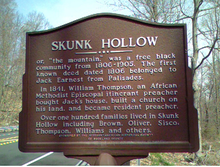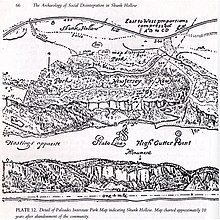Skunk Hollow
Skunk Hollow was a community of free African Americans that existed about a mile south of Alpine, New Jersey near the Palisades Highway.[1] It was also known by its inhabitants as "The Mountain".

On or about January 1, 1806 was the first cited deed to a property in Skunk Hollow was purchased by a Jack Earnest for $87.50 (~$1,705 in 2023) for five acres and 30 square rods.[2] In 1822 Earnest purchased another six acres.
The settlers of Skunk Hollow appear to be free African-Americans who settled as early as 1854, on land that may have been acquired in 1840 by a freed slave named James Oliver.
William Thomson, a minister (known as "reverend Billy"), the spiritual leader of the settlement, organized a church in Skunk Hollow that was built between 1856 and 1860. By 1880 Skunk Hollow had a population of 75 people, according to census records, only to drop to six households of 26 people by 1885. The settlement was largely abandoned by 1886 after Reverend Billy's death.[3] In 1903 it was incorporated in the Borough of Alpine, New Jersey.

While the settlement was largely abandoned by 1911, other sections of The Mountain< were occupied as late as 1979.[1]
In the 2000s, researcher Joan Geismar, a graduate student at Columbia University working on her doctorate, researched Skunk Hollow. The research included an archeological dig.[4] According to the research, the settlement of Skunk Hollow moved to nearby towns in the early 1900 after the death of Rev. William Thompson around 1885.
The name Skunk Hollow is thought to originate from the smell of foliage that was in abundance in the area and also identified as "skunk cabbage". The cabbage's leaves are named for their smell . The area was also called "Turkey Ridge" by some locals on the New York side.
References
[edit]- ^ a b Sykes, Kathleen (March 2006). "Skunk Hollow: History of a 19th Century Community of Free African-Americans". 10964 - The Palisades Newsletter. No. 192. Retrieved 25 November 2022.
- ^ Schneider, Mike (27 February 2015). "Freed Slaves Created Skunk Hollow Community". NJ Spotlight News. Retrieved 25 November 2022.
- ^ Lewis, Zen (29 August 2017). "Skunk Hollow". African American Historical Society of Rockland County. Retrieved 25 November 2022.
- ^ Geismar, Joan H. (1982). The Archaeology of Social Disintegration in Skunk Hollow: A Nineteenth-century Rural Black Community. Academic Press. ISBN 978-0-12-279020-1. Retrieved 25 November 2022.
